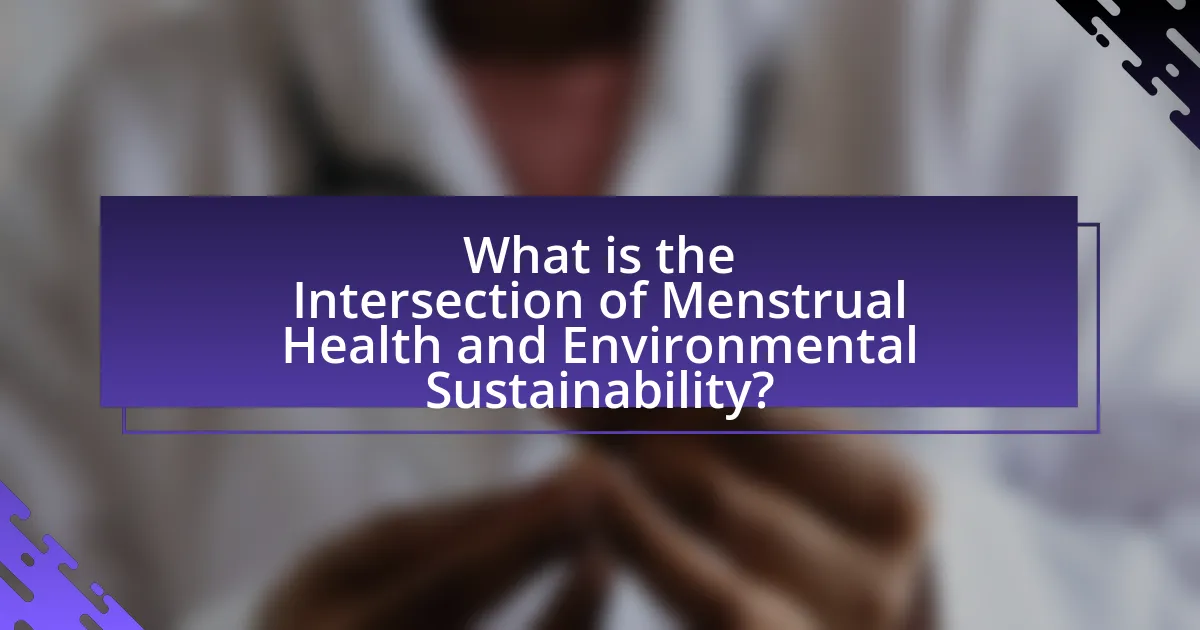The article examines the intersection of menstrual health and environmental sustainability, highlighting the significant ecological impact of traditional menstrual products such as pads and tampons, which contribute to substantial waste and pollution. It discusses the benefits of sustainable alternatives like menstrual cups and reusable cloth pads, which not only reduce waste but also promote better health by minimizing exposure to harmful chemicals. Key components of menstrual health, including hygiene management and access to information, are explored alongside the environmental challenges posed by disposable products. The article emphasizes the importance of education and advocacy in improving menstrual health practices and promoting sustainable options, ultimately aiming to align personal health with environmental sustainability goals.

What is the Intersection of Menstrual Health and Environmental Sustainability?
The intersection of menstrual health and environmental sustainability lies in the impact of menstrual products on both individual health and ecological systems. Menstrual products, particularly single-use items like pads and tampons, contribute significantly to waste, with an estimated 300 million menstrual products disposed of daily worldwide, leading to environmental pollution. Sustainable alternatives, such as menstrual cups and reusable cloth pads, not only reduce waste but also promote better menstrual health by minimizing exposure to harmful chemicals found in conventional products. Research indicates that adopting sustainable menstrual practices can decrease the carbon footprint associated with menstrual product production and disposal, thereby supporting both personal health and environmental sustainability.
How do menstrual health and environmental sustainability relate to each other?
Menstrual health and environmental sustainability are interconnected through the environmental impact of menstrual products and the importance of access to sustainable options. Traditional menstrual products, such as pads and tampons, contribute significantly to waste, with an estimated 45 billion menstrual products disposed of annually in the U.S. alone, leading to increased landfill waste and pollution. In contrast, sustainable menstrual health practices, including the use of reusable products like menstrual cups and cloth pads, reduce waste and promote environmental stewardship. Research indicates that switching to reusable menstrual products can decrease waste by up to 90%, highlighting the potential for improved menstrual health to align with environmental sustainability goals.
What are the key components of menstrual health?
The key components of menstrual health include menstrual hygiene management, access to accurate information, and the availability of healthcare services. Menstrual hygiene management involves the use of safe and effective menstrual products, which is crucial for preventing infections and promoting overall health. Access to accurate information ensures that individuals understand their menstrual cycles, which can help in recognizing abnormalities and seeking timely medical advice. Availability of healthcare services provides necessary support for menstrual-related issues, including menstrual disorders and reproductive health. These components are essential for maintaining physical and mental well-being during menstruation, as supported by the World Health Organization’s guidelines on menstrual health.
What are the main environmental sustainability issues related to menstrual products?
The main environmental sustainability issues related to menstrual products include plastic waste, resource consumption, and chemical pollution. Disposable menstrual products, such as pads and tampons, often contain plastic components that contribute to landfill waste, with an estimated 300 million menstrual products disposed of daily worldwide. Additionally, the production of these products requires significant natural resources, including water and energy, leading to environmental degradation. Furthermore, many menstrual products are treated with chemicals that can leach into the environment, posing risks to ecosystems and human health. These factors highlight the urgent need for sustainable alternatives in menstrual health.
Why is it important to address menstrual health in the context of environmental sustainability?
Addressing menstrual health in the context of environmental sustainability is crucial because menstrual products significantly contribute to environmental waste. For instance, it is estimated that over 45 billion menstrual products are disposed of annually, leading to substantial landfill accumulation and pollution. Furthermore, many conventional menstrual products contain plastics that take hundreds of years to decompose, exacerbating environmental degradation. By promoting sustainable menstrual health solutions, such as reusable products, we can reduce waste and lower the carbon footprint associated with menstrual care, thereby supporting broader environmental sustainability goals.
How does menstrual health impact women’s overall health and well-being?
Menstrual health significantly impacts women’s overall health and well-being by influencing physical, emotional, and social aspects of their lives. Proper menstrual health management can prevent complications such as reproductive disorders, which affect approximately 10% of women of reproductive age, according to the World Health Organization. Additionally, menstrual health is linked to mental health; women experiencing menstrual-related disorders often report higher levels of anxiety and depression. Furthermore, access to menstrual hygiene products is crucial; studies show that inadequate menstrual health resources can lead to school absenteeism, affecting educational and economic opportunities for women. Thus, menstrual health is integral to women’s holistic health and societal participation.
What are the environmental consequences of traditional menstrual products?
Traditional menstrual products, such as disposable pads and tampons, contribute significantly to environmental pollution. These products are primarily made from plastic and other non-biodegradable materials, leading to long-lasting waste in landfills. For instance, it is estimated that a single pad can take up to 800 years to decompose, while tampons, which often contain plastic applicators, also contribute to plastic pollution in oceans and waterways. Furthermore, the production of these products involves the use of chemicals and resources that can harm ecosystems, including the deforestation associated with cotton farming. According to a study published in the journal “Environmental Science & Technology,” the cumulative environmental impact of menstrual products is substantial, with millions of menstrual products disposed of annually, exacerbating the global plastic waste crisis.

What are the current practices in menstrual health management?
Current practices in menstrual health management include the use of sustainable menstrual products, education on menstrual hygiene, and access to healthcare services. Sustainable products such as menstrual cups, reusable cloth pads, and organic cotton tampons are increasingly promoted to reduce environmental impact. Education initiatives focus on dispelling myths and providing information about menstrual health, hygiene practices, and product options. Access to healthcare services ensures that individuals can receive necessary medical advice and treatment related to menstrual health. These practices are supported by various organizations and studies highlighting the importance of sustainable menstrual management for both health and environmental sustainability.
How do different menstrual products affect the environment?
Different menstrual products have varying environmental impacts, primarily due to their materials and disposal methods. Disposable products, such as pads and tampons, contribute significantly to landfill waste, with an estimated 20 billion pads and tampons disposed of annually in the U.S. alone, taking hundreds of years to decompose. In contrast, reusable products like menstrual cups and cloth pads reduce waste and resource consumption, as they can last several years with proper care. Research indicates that switching to reusable menstrual products can reduce carbon footprints by up to 90% compared to disposables. Additionally, the production of disposable products often involves the use of plastics and chemicals, which can lead to pollution and harm ecosystems. Thus, the choice of menstrual product directly influences environmental sustainability.
What are the environmental impacts of disposable menstrual products?
Disposable menstrual products, such as pads and tampons, significantly contribute to environmental pollution. These products are primarily made from plastic and other non-biodegradable materials, which can take hundreds of years to decompose in landfills. According to a study published in the journal “Environmental Science & Technology,” an estimated 20 billion menstrual products are disposed of annually in the United States alone, leading to substantial waste accumulation. Furthermore, the production process of these products involves resource-intensive practices, including deforestation for cotton cultivation and high water usage, exacerbating their environmental footprint. The combination of waste generation and resource depletion highlights the detrimental environmental impacts associated with disposable menstrual products.
How do reusable menstrual products contribute to sustainability?
Reusable menstrual products contribute to sustainability by significantly reducing waste and resource consumption associated with single-use products. Traditional menstrual products, such as pads and tampons, generate approximately 200,000 tons of waste annually in the U.S. alone, as they are typically made from non-biodegradable materials. In contrast, reusable options like menstrual cups and cloth pads can last several years, drastically decreasing the volume of waste produced. Additionally, the production of single-use products requires substantial resources, including water and energy; by using reusable products, individuals can minimize their ecological footprint. Studies indicate that switching to reusable menstrual products can reduce carbon emissions by up to 90% compared to disposable products, highlighting their role in promoting environmental sustainability.
What innovations are emerging in menstrual health and sustainability?
Innovations in menstrual health and sustainability include the development of biodegradable menstrual products, reusable menstrual cups, and period underwear made from sustainable materials. Biodegradable products, such as those made from organic cotton or bamboo, reduce landfill waste and environmental impact. Reusable menstrual cups can last for years, significantly decreasing the number of disposable products used. Additionally, period underwear, which is designed to be washable and reusable, offers a sustainable alternative to traditional pads and tampons. These innovations are supported by research indicating that the menstrual product industry generates significant waste, with an estimated 20 billion pads and tampons disposed of annually in the U.S. alone, highlighting the need for sustainable solutions.
How are companies developing eco-friendly menstrual products?
Companies are developing eco-friendly menstrual products by utilizing sustainable materials and innovative designs. For instance, many brands are now producing menstrual pads and tampons made from organic cotton, bamboo, and biodegradable materials, which significantly reduce environmental impact compared to conventional products that often contain plastics. Additionally, companies are creating reusable menstrual cups and cloth pads, which can last for years, thereby minimizing waste. Research indicates that switching to reusable products can reduce menstrual product waste by up to 90% over a lifetime. This shift not only addresses environmental concerns but also promotes healthier options for consumers.
What role does technology play in promoting sustainable menstrual health solutions?
Technology plays a crucial role in promoting sustainable menstrual health solutions by enabling the development of eco-friendly products and improving access to menstrual health information. Innovations such as biodegradable menstrual products, reusable menstrual cups, and apps that track menstrual cycles contribute to reducing waste and environmental impact. For instance, a study published in the journal “Environmental Science & Technology” found that switching to reusable menstrual products can significantly decrease the amount of plastic waste generated from single-use items. Additionally, technology facilitates education and awareness through digital platforms, allowing individuals to access vital information about menstrual health and sustainability practices, thereby fostering informed choices.

What challenges exist at the intersection of menstrual health and environmental sustainability?
Challenges at the intersection of menstrual health and environmental sustainability include the environmental impact of menstrual products, access to sustainable options, and the stigma surrounding menstruation. Conventional menstrual products, such as pads and tampons, contribute significantly to plastic waste, with an estimated 45 billion menstrual products disposed of annually in the U.S. alone, leading to long-term environmental pollution. Additionally, many individuals lack access to eco-friendly menstrual products due to cost and availability, which can hinder their ability to make sustainable choices. Furthermore, societal stigma surrounding menstruation can prevent open discussions about sustainable practices, limiting awareness and education on environmentally friendly options.
What barriers do individuals face in accessing sustainable menstrual products?
Individuals face several barriers in accessing sustainable menstrual products, including cost, availability, and lack of awareness. The higher price point of sustainable options, such as menstrual cups and organic cotton pads, often makes them less accessible to low-income individuals. Additionally, these products may not be readily available in all regions, particularly in rural or underserved areas, limiting access. Furthermore, a lack of education and awareness about the benefits and use of sustainable menstrual products contributes to lower adoption rates, as many individuals may not be informed about their options or how to use them effectively.
How do cultural perceptions influence menstrual health practices?
Cultural perceptions significantly influence menstrual health practices by shaping beliefs, taboos, and behaviors surrounding menstruation. For instance, in many cultures, menstruation is viewed as a source of shame or impurity, leading to practices that isolate menstruators or restrict their activities during their menstrual cycle. Research indicates that in some communities, these perceptions can result in inadequate access to menstrual hygiene products and education, which directly impacts health outcomes. A study published in the journal “BMC Women’s Health” found that cultural stigma surrounding menstruation often leads to misinformation and a lack of resources, ultimately affecting the physical and mental well-being of menstruators. Thus, cultural perceptions play a crucial role in determining how menstrual health is managed and understood within different societies.
What economic factors affect the availability of sustainable options?
Economic factors that affect the availability of sustainable options include production costs, market demand, and government policies. High production costs for sustainable products, such as organic materials or eco-friendly manufacturing processes, can limit their availability compared to cheaper, conventional alternatives. Market demand influences the supply chain; if consumers prioritize sustainability, manufacturers are more likely to invest in sustainable options. Additionally, government policies, such as subsidies for sustainable practices or taxes on non-sustainable products, can either promote or hinder the availability of sustainable options. For instance, countries that provide financial incentives for sustainable agriculture often see a greater variety of eco-friendly products in the market.
How can education and awareness improve menstrual health and sustainability?
Education and awareness can significantly improve menstrual health and sustainability by providing individuals with knowledge about menstrual hygiene management and eco-friendly products. Increased understanding of menstrual health leads to better practices, such as the use of reusable menstrual products, which can reduce waste. For instance, research indicates that switching from disposable pads and tampons to reusable options can decrease menstrual product waste by up to 90% over a lifetime. Furthermore, awareness campaigns can challenge stigmas surrounding menstruation, encouraging open discussions that promote health-seeking behaviors and access to necessary resources. This holistic approach not only enhances individual health outcomes but also contributes to environmental sustainability by minimizing the ecological footprint associated with menstrual products.
What role do schools and communities play in promoting menstrual health education?
Schools and communities play a crucial role in promoting menstrual health education by providing accurate information, fostering open discussions, and creating supportive environments. Schools implement comprehensive health curricula that include menstrual health, which helps to normalize the topic and reduce stigma. Community organizations often collaborate with schools to offer workshops and resources, ensuring that both students and parents are informed about menstrual hygiene management and health. Research indicates that when schools and communities engage in menstrual health education, it leads to improved knowledge and attitudes among adolescents, as evidenced by a study published in the Journal of Adolescent Health, which found that comprehensive education programs significantly increased students’ understanding of menstrual health.
How can campaigns raise awareness about the environmental impact of menstrual products?
Campaigns can raise awareness about the environmental impact of menstrual products by utilizing educational content, social media engagement, and community outreach initiatives. Educational content can include infographics and articles that highlight the waste generated by single-use products, such as the fact that approximately 20 billion menstrual products are disposed of annually in the U.S. alone, contributing significantly to landfill waste. Social media platforms can amplify these messages through targeted campaigns that encourage discussions around sustainable alternatives, such as menstrual cups and reusable pads. Community outreach initiatives can involve workshops and events that provide hands-on experiences with eco-friendly products, fostering a deeper understanding of their benefits. These strategies collectively inform the public about the environmental consequences of traditional menstrual products and promote sustainable practices.
What practical steps can individuals take to support menstrual health and environmental sustainability?
Individuals can support menstrual health and environmental sustainability by choosing eco-friendly menstrual products, such as reusable menstrual cups or cloth pads. These alternatives significantly reduce waste compared to single-use products like tampons and pads, which contribute to the estimated 20 billion menstrual products disposed of annually in the U.S. alone. Additionally, individuals can advocate for better menstrual health education and policies that promote access to sustainable products, thereby addressing both health and environmental concerns. Engaging in community discussions and supporting brands that prioritize sustainability also fosters a culture of awareness and responsibility regarding menstrual health and environmental impact.
What are the best practices for choosing sustainable menstrual products?
The best practices for choosing sustainable menstrual products include selecting items made from organic, biodegradable materials, such as cotton or bamboo, which reduce environmental impact. Additionally, opting for reusable products like menstrual cups or cloth pads minimizes waste, as they can last for several years compared to single-use products. Research indicates that using a menstrual cup can reduce menstrual product waste by up to 90% over a decade. Furthermore, verifying certifications, such as GOTS (Global Organic Textile Standard) for organic materials, ensures that products meet sustainability criteria.
How can individuals advocate for better menstrual health policies and practices?
Individuals can advocate for better menstrual health policies and practices by engaging in community education and awareness campaigns. These initiatives can highlight the importance of menstrual health, promote sustainable menstrual products, and address the stigma surrounding menstruation. Research indicates that education can significantly improve menstrual health outcomes, as seen in studies where awareness programs led to increased knowledge and better practices among participants. Additionally, individuals can collaborate with local organizations to influence policymakers, ensuring that menstrual health is included in public health agendas. This approach is supported by evidence showing that advocacy efforts can lead to policy changes that improve access to menstrual products and health services, ultimately benefiting community health and sustainability.



